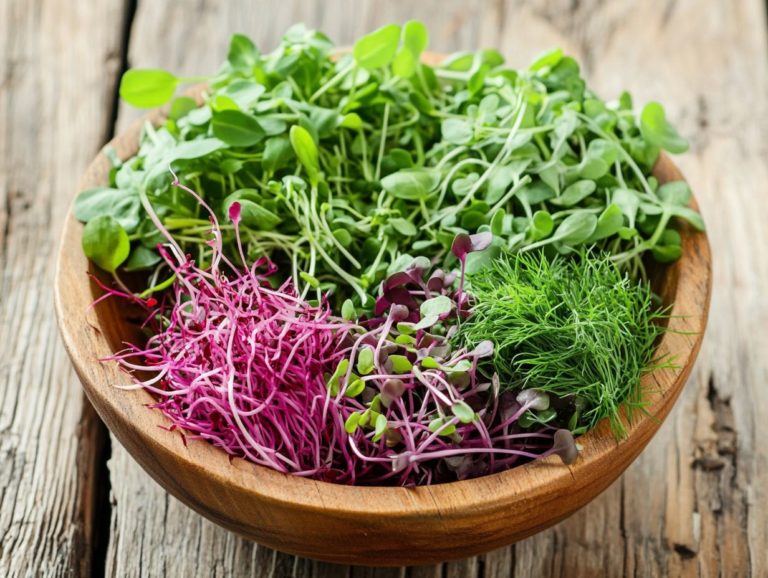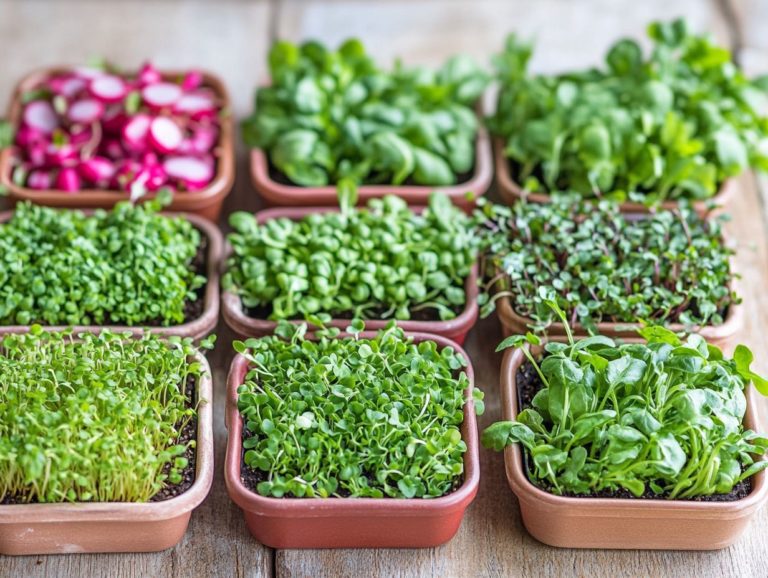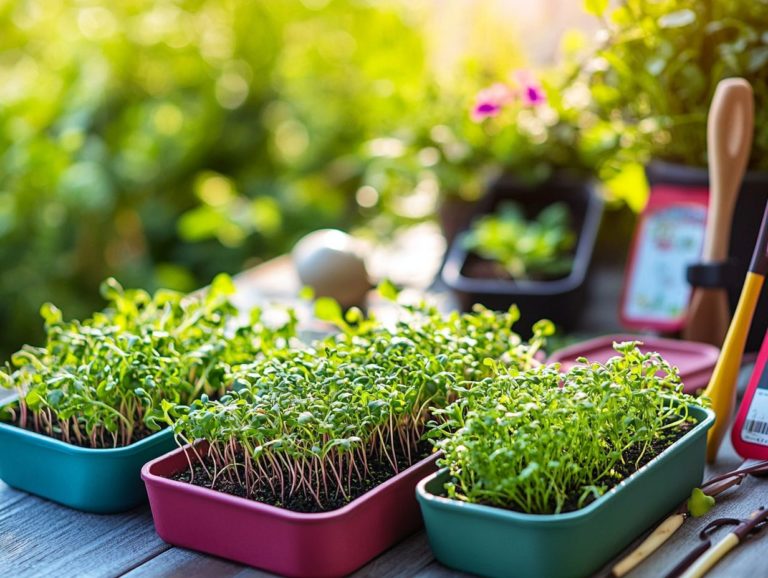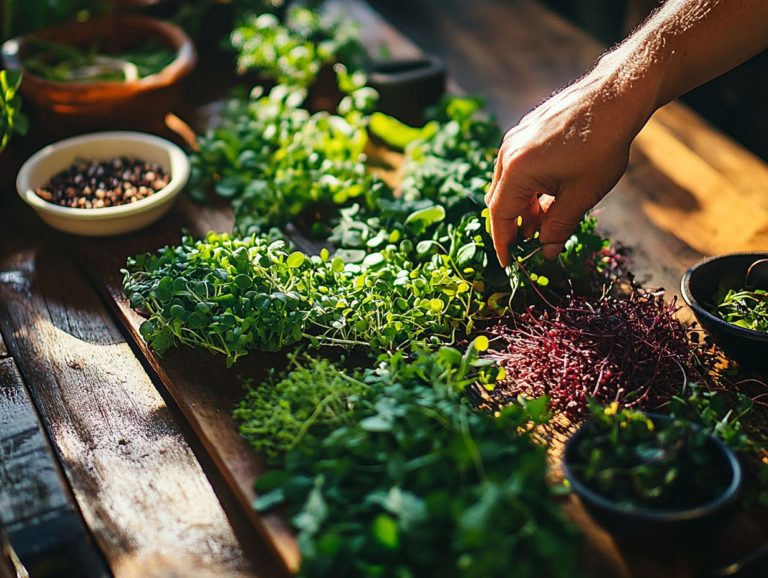Top 5 Microgreen Varieties for Breakfast
Microgreens are not merely a trendy garnish; they deliver a remarkable nutritional punch that can elevate your breakfast experience to new heights. They are a worthwhile investment for health-conscious individuals.
You ll uncover the top five microgreen varieties broccoli, sunflower, pea shoots, radish, and beet that not only enhance flavor but also boost your health, making them a fantastic choice for any beginner gardener.
Discover why these tiny greens are the ideal addition to your morning meals, along with their impressive nutritional benefits and innovative recipes to incorporate them into your dishes.
You ll also get valuable tips on how to grow them at home using techniques like hydroponics and important precautions to keep in mind. Don t miss out on transforming your meals with these vibrant and nutritious delights!
Contents
Key Takeaways:
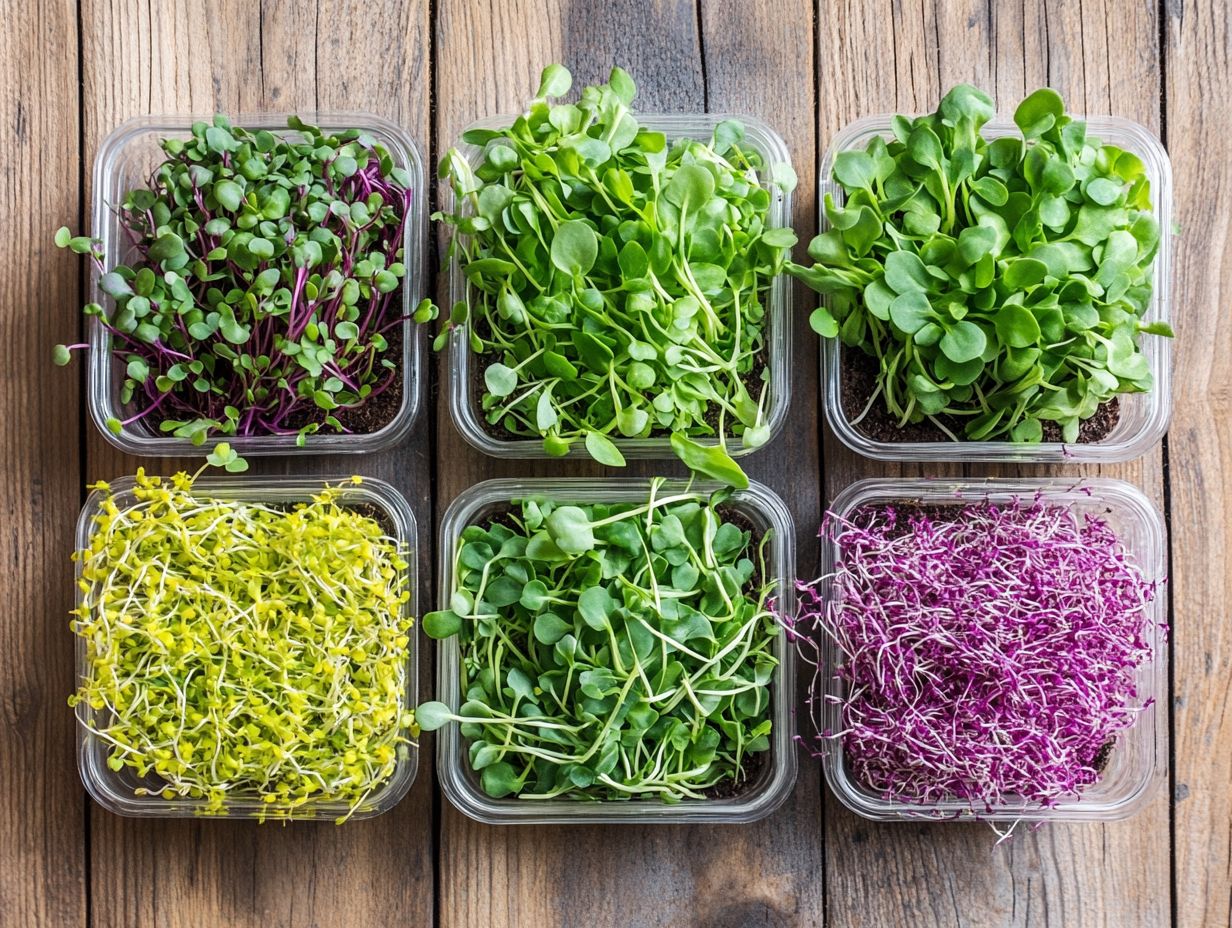
- Broccoli microgreens provide vitamin C, folate, and fiber for a nutritious breakfast.
- Sunflower microgreens are rich in B vitamins and healthy fats, making them a great addition to breakfast smoothies or avocado toast. Their crunchy texture adds a delightful twist to any meal.
- Pea shoot microgreens are high in iron and protein, perfect for breakfast bowls or omelettes.
1. Broccoli Microgreens
Broccoli microgreens are a fantastic, nutritious addition to your diet. They offer numerous health benefits that make them a top choice for both novice and seasoned gardeners.
These tiny greens are powerful, brimming with essential vitamins, minerals, and antioxidants, and are incredibly easy to cultivate from organic seeds and quick-growing varieties like arugula and basil.
With their quick germination and straightforward growing process, you can easily grow broccoli microgreens in trays using nutrient-rich soil mixtures or potting soil, ensuring a rewarding harvest in just a few days.
Rich in vitamins A, C, E, and K, and vital minerals like calcium and iron, the nutritional profile of these microgreens actively supports your immune function and overall health. Try using a blend of compost and organic peat for the best results!
Regular watering is key keep the soil slightly moist but never waterlogged to prevent a condition that can cause seedlings to rot. Using coir can help with moisture retention while ensuring the right balance is achieved.
Plus, the nutty and peppery flavor of broccoli microgreens adds a delightful twist to your salads, sandwiches, and wraps, elevating your culinary creations with a refreshing burst of taste and nutrition, ideal for traditional breakfast dishes.
2. Sunflower Microgreens
Sunflower microgreens are not just a feast for the eyes with their vibrant colors; they also bring a delightful crunch and nutty flavor that can elevate a variety of dishes.
These petite greens flourish in well-drained soil, soaking up sunlight while requiring careful attention to moisture levels to truly thrive. Their profile is rich in nutrients, boasting high amounts of vitamins A, C, and E, along with an abundance of antioxidants that support overall well-being.
In the kitchen, sunflower microgreens are incredibly versatile. They can elevate your salads, add a fresh twist to sandwiches, or serve as a lovely garnish for soups and smoothies, enriching the flavors in every bite.
Incorporating them into your daily meals not only enhances visual appeal but also offers an effortless way to boost your nutrient intake, promoting a balanced and healthy lifestyle.
3. Pea Shoot Microgreens
Pea shoot microgreens add a sweet burst of flavor and tender texture to your meals. They re perfect for salads and wraps.
To cultivate these charming greens successfully, start by selecting soil that drains well and is rich in nutrients. A seed tray filled with potting mix or a mix with coir works well for both indoor and outdoor settings.
Water gently to avoid disturbing the seeds. It s important to maintain consistent moisture without waterlogging for robust growth.
Not only do pea shoots elevate your meals with their vibrant appeal, but they also boast impressive health benefits, being high in fiber and packed with vitamins A, C, and K. Get creative! Use them to spice up your favorite dishes, like sprinkling them on a gourmet sandwich or blending them into smoothies for an extra nutrient boost.
They also make a colorful garnish on soups. Their versatility in the kitchen will undoubtedly inspire your creativity while supporting a well-rounded diet.
4. Radish Microgreens
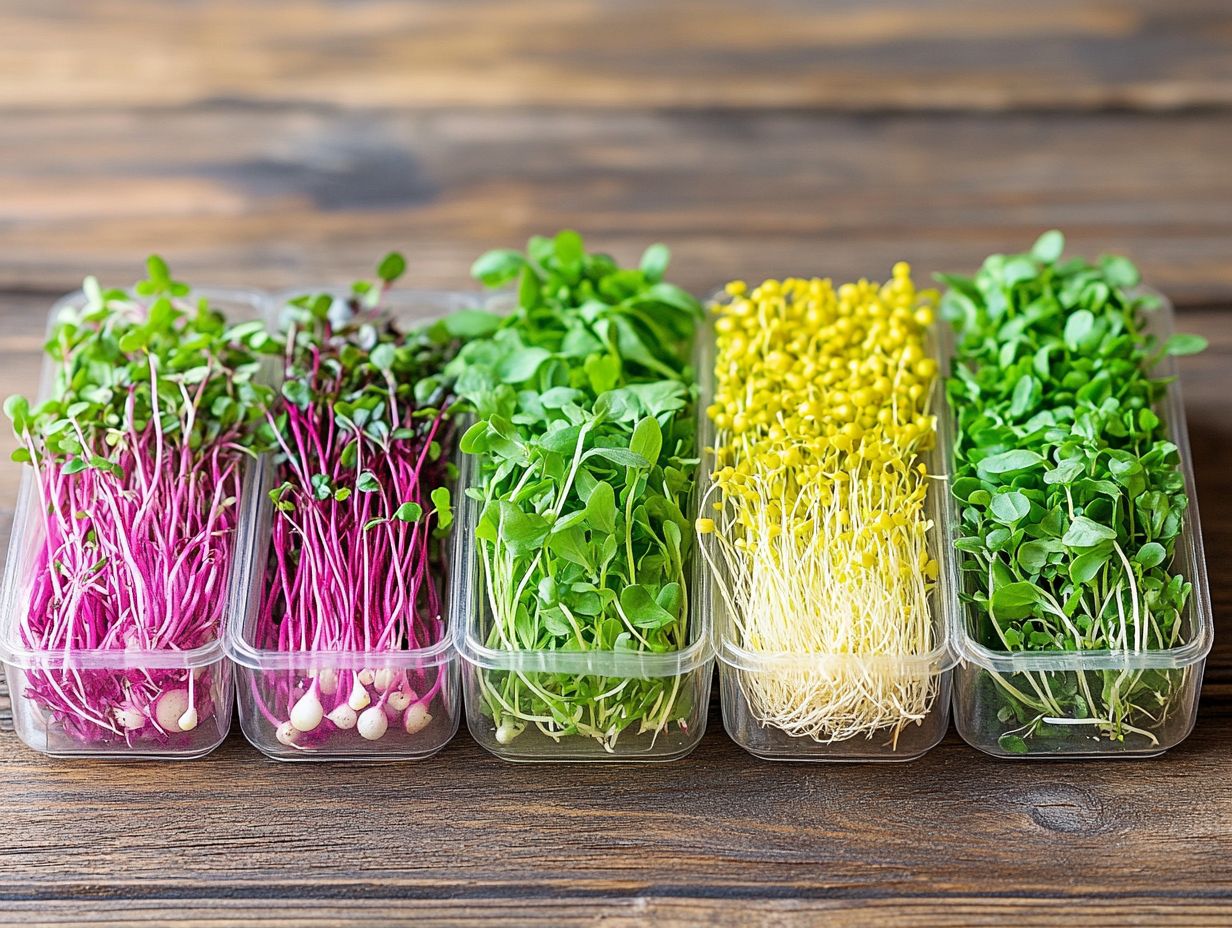
Radish microgreens bring a spicy kick that lifts your dishes. They re small but pack a punch of flavor and nutrients, making them perfect for adding to your favorite recipes.
Cultivating these vibrant greens at home is surprisingly simple. They thrive in well-drained soil or a growing medium that retains moisture without becoming overly soggy.
For optimal growth, ensure they bask in bright light for at least 12-16 hours each day. This allows for quicker germination and vibrant colors, helping them develop their robust flavor profile.
Packed with vitamins A, C, and E, along with essential minerals, these microgreens enhance salads and sandwiches. They make a delightful, nutritious garnish for soups or stir-fries, adding flavor to everyday meals while boosting their nutritional value.
5. Beet Microgreens
Beet microgreens are not just colorful; they re also packed with health benefits. Their earthy taste adds depth to your meals.
These vibrant greens flourish in well-draining, nutrient-rich soil, allowing their roots to spread freely. Maintaining the right balance in watering is crucial; keep the soil consistently moist without turning it soggy. Using quality soil mixtures will help achieve this.
Rich in antioxidants, beet microgreens are a fantastic addition to your diet, especially when combined with other vegetable greens for added flavor. They seamlessly enhance salads, smoothies, and sandwiches.
Their unique taste can elevate grain bowls or serve as a lively garnish on various protein dishes, delivering a refreshing burst that enhances both flavor and nutritional value.
Why Are Microgreens Ideal for Breakfast?
Microgreens are perfect for breakfast! They make it easy to boost the nutrition and flavor of your morning meals.
These small greens are full of vitamins, minerals, and antioxidants, making them a convenient source of nutrients that can elevate traditional dishes.
Imagine radish microgreens adding a peppery kick to your omelet. They make your breakfast not just healthier, but tastier too!
Incorporating them into your breakfast routine is a breeze. Sprinkle them over avocado toast for an extra burst of flavor or fold them into scrambled eggs for a delightful twist, enhancing the dish with vibrant colors and flavors.
With their versatility and rich taste, microgreens not only elevate your meals but also support a healthier lifestyle.
What Are the Nutritional Benefits of Microgreens?
Microgreens are truly a treasure trove of nutrients, brimming with vitamins, minerals, and antioxidants that can elevate your diet to new heights. They are a fantastic addition to your vegetable intake. These petite greens often boast concentrations of vitamins A, C, E, and K that outshine their fully grown counterparts, along with essential minerals like calcium and magnesium.
Take mature spinach, known for its iron content. Varieties like radish microgreens can actually offer even greater amounts of certain beneficial compounds, enhancing their health benefits. By incorporating microgreens into your meals, you not only introduce vibrant flavors but also play a proactive role in preventing chronic diseases due to their high antioxidant levels that fight off cellular damage.
Just a small handful of these nutrient-rich greens tossed into salads or sandwiches can transform a simple dish into a health-boosting powerhouse, making them an excellent substitute for traditional ingredients.
How Can Microgreens Be Incorporated into Breakfast Meals?

Incorporating microgreens into your breakfast is not only simple but also incredibly versatile. They enhance the flavor and nutritional value of your favorite dishes think omelets, sandwiches, and salads.
By adding these vibrant greens, you can effortlessly boost your intake of vitamins, minerals, and antioxidants while enriching your everyday recipes. For example, a basic omelet can easily transform into a gourmet delight by folding in a handful of peppery arugula or fresh basil microgreens just before serving.
If you re a sandwich enthusiast, layering them with avocado and smoked salmon adds a burst of flavor while packing in essential nutrients, making every bite tasty and nutritious.
In your smoothies, a scoop of sunflower or pea microgreens can introduce an earthy undertone, creating a deliciously healthy option. Try adding them to your meals today!
What Are the Different Ways to Grow Microgreens at Home?
Growing microgreens at home opens up a world of possibilities and is easily accessible to gardeners of every skill level. Using trays with various types of soil can set the stage for success.
Many enthusiasts choose a well-draining potting mix or coconut coir, as these options create an optimal environment for robust root development. For watering, consider a gentle misting technique; it keeps the soil moist without risking waterlogged conditions that can lead to mold issues.
Choose organic seeds for better flavor and health. By incorporating high-quality light sources and fine-tuning the temperature, you can enhance growth potential, ensuring your microgreens reach their maximum yield and taste.
Are There Any Precautions to Take When Consuming Microgreens?
While microgreens present an array of health benefits, it’s crucial to take certain precautions to ensure safety and avoid potential contamination.
- Sourcing organic seeds is your first step, as these guarantee that the microgreens are grown without harmful pesticides or synthetic fertilizers.
- Wash microgreens gently under cool water to remove any lingering soil or contaminants. A salad spinner is useful for eliminating excess moisture, as wet microgreens can spoil quickly.
- For storage, opt for a breathable container in the refrigerator. This not only prolongs their freshness but also preserves their vibrant flavors.
Pay special attention to varieties like radish or cabbage microgreens; they can be more susceptible to bacterial growth, making these precautions even more important for health-conscious consumers.
In conclusion, microgreens are an excellent way to enhance your meals, providing vibrant flavors and essential nutrients that promote better health!
What Are the Other Uses of Microgreens Beyond Breakfast?
Microgreens are more than a breakfast ingredient. They can elevate salads and serve as elegant garnishes, showcasing their versatility and health benefits.
You can add microgreens to a filling bowl of grains. Imagine mixing quinoa with roasted vegetables and a handful of peppery arugula microgreens for that extra kick.
They also work wonders in a sandwich. Layer mustard microgreens with turkey and avocado for a flavor explosion.
At dinner, think about using microgreens as a stunning garnish for grilled salmon. This enhances both the aesthetics and the nutritional benefits of your meal.
A sprinkle of beet microgreens can transform a simple plate of pasta or risotto, adding not just a pop of color but an earthy flavor as well.
The ways to enjoy these nutritious greens in your meals are limitless! Dive in and explore!
Frequently Asked Questions
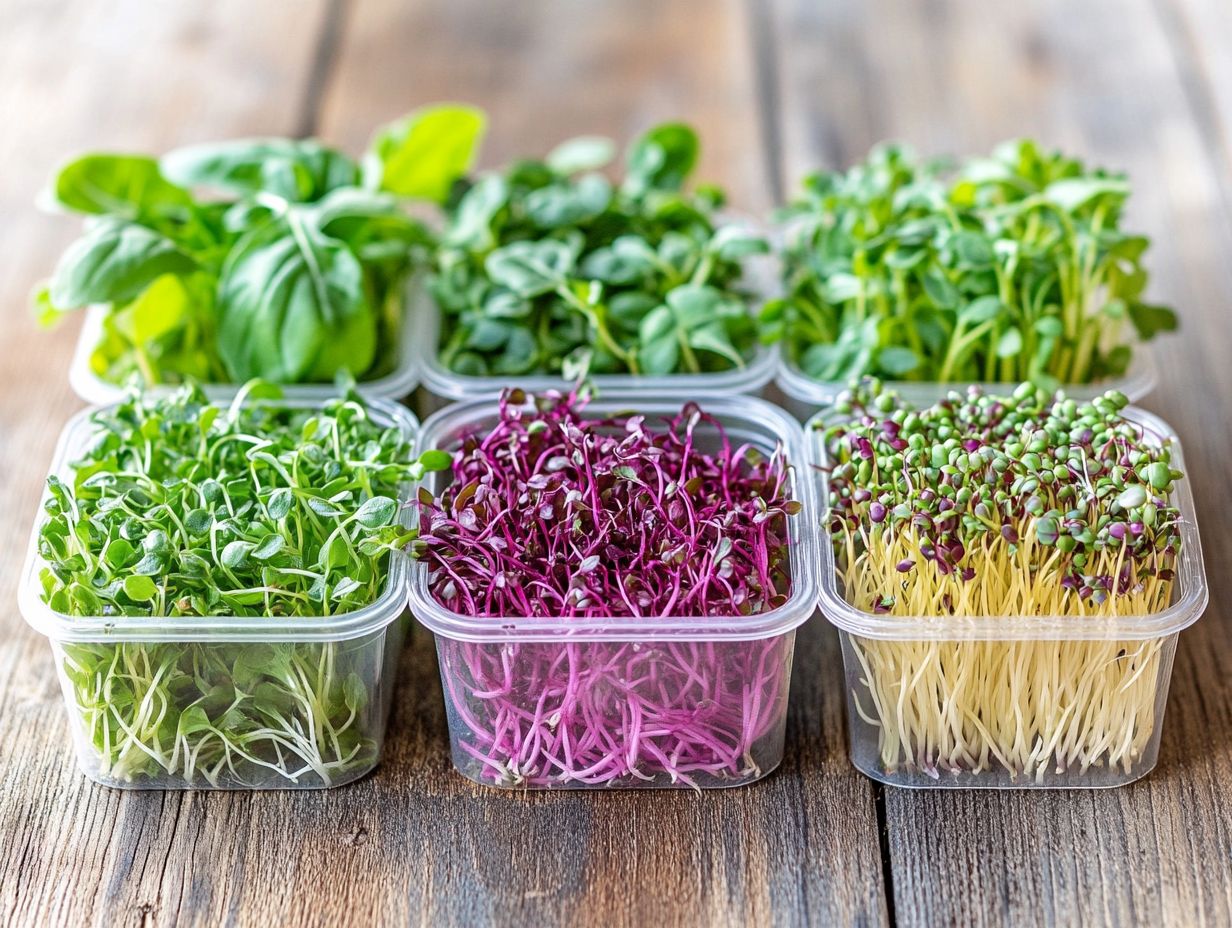
What are the top 5 microgreen varieties for breakfast?
The top 5 microgreen varieties for breakfast are broccoli, kale, radish, pea, and sunflower.
Why are microgreens a great choice for breakfast?
Microgreens are a great choice for breakfast because they are packed with nutrients and can add flavor and texture to your morning meal.
Which microgreen variety is best for adding a crunch to breakfast dishes?
Radish microgreens are known for their crunchy texture, making them the perfect addition to breakfast dishes like avocado toast or omelettes.
How can I incorporate microgreens into my breakfast routine?
You can easily incorporate microgreens into your breakfast routine by adding them to smoothies, breakfast bowls, or as a topping for your favorite breakfast foods.
Are there any health benefits to consuming microgreens for breakfast?
Yes, there are many health benefits to consuming microgreens for breakfast. They are high in vitamins, minerals, and antioxidants, and can help boost your immune system and improve digestion.
Can I grow my own microgreens at home for breakfast?
Yes, you can grow your own microgreens at home for breakfast! They are easy to grow and require minimal space and equipment. Plus, you can have a fresh supply of microgreens on hand for your morning meals.

